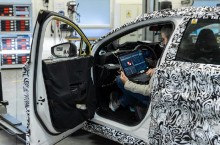CIO en VO : les européens champions du monde d'usage de smartphones
Au cours des cinq dernières années, la quantité de données échangées par les appareils mobiles a doublé avec un rythme annuel. Mais les usages des outils mobiles ne sont pas identiques partout. Selon une étude de Cisco Systems, les européens sont champions du monde.
PublicitéMobile data traffic is likely to more than double every year for the next five years, driven by video services, and the heaviest users are likely to be Europeans, according to Cisco Systems, which has just published an update to its Visual Networking Index data traffic forecast. In Europe, even those with the most primitive data-capable handsets, without a 3G connection, are likely to consume over 18MB of data a month by 2013, more than twice that of their U.S. counterparts, according to Cisco. Last year, the figure was just 800KB in Europe, and 400KB in the U.S. Europeans with the fastest smartphones, with data connections variously known as 3.5G, 3G+ or HSPA (High Speed Packet Access), will consume around 1.18GB a month by 2013, up from around 73MB a month last year, said Cisco's Arielle Sumits. U.S. power users will likely trail the Europeans, consuming only 739MB a month by 2013, up from 32MB last year. Where Cisco really expects usage to take of, though, is on the laptop, where by 2013 subscribers with cellular data cards are likely to be consuming almost 5GB a month in Europe, and 4.3GB a month in the U.S., up from an average of 630MB and 528MB respectively last year. The biggest driver will be mobile video services, accounting for 64 percent of all mobile traffic by 2013, according to Cisco's Arielle Sumits. Phone makers might as well leave out that second camera designed for video calling, though: While video conferencing and video telephony will play a part, most video traffic will be one way, generated by people watching clips on YouTube and especially Hulu, where the higher definition and longer format means more bytes per clip. Cisco compiles forecasts of network usage from a number of sources to arrive at its own predictions, which it updates twice a year, looking at mobile traffic at the start of the year, and fixed network traffic mid-year. One thing that won't change is that a few voracious users will account for a lot of the traffic: 30 percent of it will come from just 1 percent of subscribers, said Sumits. Such imbalances initially caught some mobile network operators out, leading them to impose traffic restrictions on plans they had sold as "unlimited," angering customers. That's less likely to happen in future, according to Cisco's Doug Webster: "Operators own internal forecasts have increased dramatically: They are looking to get ahead of this trend," he said. Peter Sayer - Copyright © 2008 IDG News Service. All rights reserved. IDG News Service is a trademark of International Data Group, Inc.
Article rédigé par
IDG News Service










Commentaire
INFORMATION
Vous devez être connecté à votre compte CIO pour poster un commentaire.
Cliquez ici pour vous connecter
Pas encore inscrit ? s'inscrire